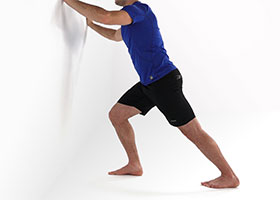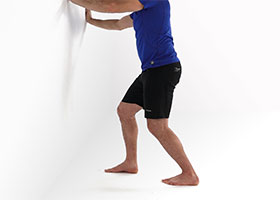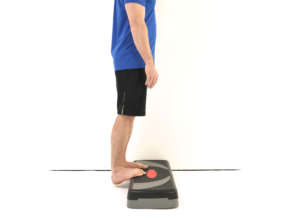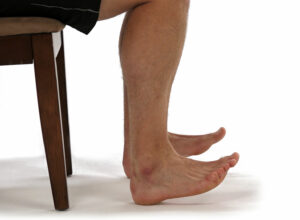- Reference Number: HEY-249/2021
- Departments: Orthopaedics, Physiotherapy
- Last Updated: 25 January 2021
Introduction
This leaflet has been produced to give you general information about your condition. Most of your questions should be answered by this leaflet. It is not intended to replace the discussion between you and the healthcare team, but may act as a starting point for discussion. If after reading it you have any concerns or require further explanation, please discuss this with a member of the healthcare team.
What is the plantar fascia?
The plantar fascia is a band of thick tissue that runs along the sole of the foot. It runs from the heel bone (calcaneum) along the inside edge of the foot to the base of the toes. Its function is to help lift the arch of the foot when walking and act as a shock absorber for the whole leg.
What is plantar fasciitis?
Plantar fasciitis is a common condition that occurs when the plantar fascia becomes inflamed and irritated near where it attaches to the heel bone.
It can occur suddenly but more often it develops gradually over a period of time.
What causes this?
The cause of plantar fasciitis is not always clear, however, there are factors that are known to increase the risk of developing the condition. These are:
- If you are on your feet a lot of the time or do lots of walking, running and standing when this is not normal for you.
- If you have recently started exercising on a different surface.
- If you have been wearing shoes with poor cushioning or poor arch support.
- If you are overweight, this puts extra strain on the heel.
- If there is a sudden stretch to the sole of your foot.
- If you have tight Achilles tendon and calf muscle.
What are the symptoms?
Pain is the main symptom and can be anywhere on the underside of the heel. Pain is often worst when you take your first steps on getting up in a morning or after long periods of rest, where no weight is placed on the foot.
Gentle exercise usually helps ease the pain but being on your feet or going for a long walk often makes the pain worse.
What should I do in the first 72 hours after the injury?
As stated earlier normally individuals will present will a gradual build up of symptoms and if this is the case for you then this section is not relevant.
However, if your symptoms have come on suddenly then the most important initial treatment is aimed at controlling the pain and inflammation by following the principles of RICE:
R – Rest
Complete rest is not advisable but it is important that you prevent putting the plantar fascia under strain in the early stages of healing. The movements over the page should be done 10 times, within your limits of pain, 3 – 4 times per day:
| 1. Whilst sitting, lift your foot a few centimeters off the floor and pull your toes and ankle up towards you and then point away. |  |
| 2. Moving from your ankle joint make a circle with your foot. |
I – Ice
There are many different ways in which ice can be applied. Whichever method you choose, it is important that you wrap it in a damp towel to prevent burning the skin. Ice should be applied for 20 to 30 minutes every two hours.
Please Note:
Only use an ice pack on areas that have normal skin sensation i.e. where you can feel hot and cold.
Do not apply over an open wound.
Do not apply an ice pack to an area that has poor circulation.
During ice application check the skin every five minutes and discontinue its use if:
- the area becomes white, blue or blotchy.
- the area becomes excessively painful, numb or tingles.
C – Compression
If you have been given a tubigrip to wear, it is important this is removed if you develop any signs of poor circulation. Signs of poor circulation include pins and needles or numbness. In addition it should be removed when you go to sleep.
E – Elevation
The ankle should be elevated above the level of the heart as much as possible, as this will help to reduce and prevent swelling.
 |
Carrying out the movements of the ankle described above, while the leg is elevated, may help to reduce any swelling further. |
Consuming alcohol, massaging the injured area and applying heat can all be detrimental in the early stages of healing and therefore should be avoided.
How is plantar fasciitis treated after 72 hours?
In most cases plantar fasciitis will get better by itself but it can take several months or more to go. There are a number of things that you can try to speed up your recovery and these are described below:
Rest and Exercise
Rest your foot as much as possible, avoid running, excessive walking and long periods of standing. However do perform the specific exercises below at least twice per day:
1. Stand facing a wall and step backwards with your injured leg.
 |
Keep this leg straight with your toes pointing forward and the heel on the floor. Now bend your other knee until you feel a stretch in the calf of your injured leg. Hold this for 30 seconds and repeat 3 times per day. |
2. From the position above move your injured leg forward but keep it slightly behind your other leg.
 |
Ensure that your toes point forward and bend both knees, keeping the heel of your injured leg on the floor. You should feel a stretch in the calf of your injured leg. Hold for 30 seconds and repeat 3 times per day. |
3. Stand facing a step and place the toes of both feet on to it, letting your heels hang over the edge.
 |
Hold on to something solid for support. Lower your heels, keeping your knee straight and feel the stretch in your calves. Hold this position for 30 seconds and repeat twice each session. |
4. Sit on a chair with your knees bent at right angles and your feet flat on the floor.
 |
Lift your toes upwards, keeping your heel on the floor and feel the stretch along the bottom of the foot. Hold this position for 10 seconds and repeat 3 times each session. |
5. Using a round drinks bottle that has been chilled in the freezer, sit on a chair and place the bottle under the arch of your foot. Roll your foot forwards and backwards over the bottle for five minutes.
To ensure that you do not receive a skin burn please follow the advice, in the previous section, regarding the application of ice.
All photos with kind permission of ©Physiotec™
Footwear
Wear supportive shoes and avoid going barefoot, wearing slippers, flip flops or backless shoes. Ill fitting and worn shoes should also be avoided as they do not support the foot, have reduced shock absorbance and may lead to increase strain on the plantar fascia.
Pain Relief
To manage your pain it is advised that you regularly take simple pain relief medication which can be brought over the counter from your pharmacist. If you have allergies or conditions which prevent the use of pain relief or anti-inflammatory medication, please seek advice from your doctor or a pharmacist.
When to seek further help
If after 10 days following your attendance at the soft tissue injury clinic and despite following the advice above, you are unable to weight bear and the foot remains painful, please contact the physiotherapy team.
Should you require further advice on the issues contained in this leaflet, please do not hesitate to contact: Physiotherapy team: (01482) 608939.
If there is no answer, please leave a message clearly stating your full name, address and telephone number and we will get back to you as soon as possible.
Under the General Data Protection Regulation and the Data Protection Act 2018 we are responsible for maintaining the confidentiality of any information we hold about you. For further information visit the following page: Confidential Information about You.
If you or your carer needs information about your health and well-being and about your care and treatment in a different format, such as large print, braille or audio, due to disability, impairment or sensory loss, please advise a member of staff and this can be arranged.

